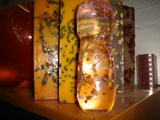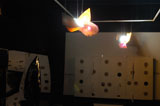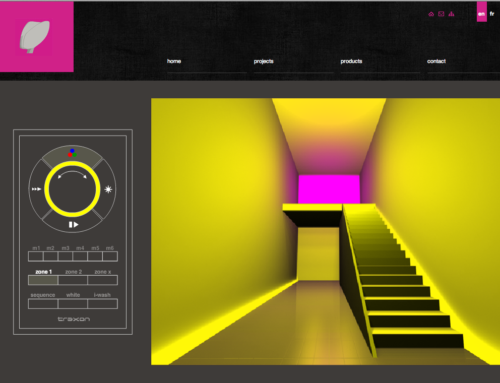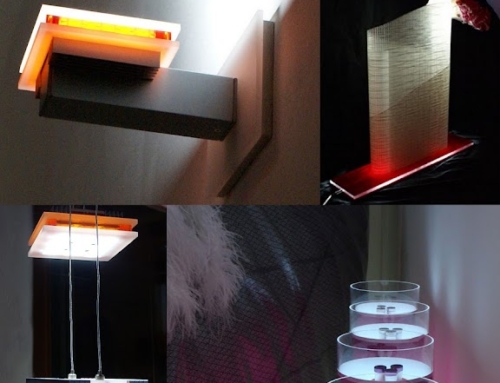 Aliki Polydor’s polisensorial lighting installation is, then, to be seen in the context of other contemporary art inquiries even though it is based on specific elements of her own sensitivity and personal style: adding LED-lighting she has creates an all-embracing quality.She does so with the lightest touch and in a clear and allusive manner. This camera obscura has a clearly feminine aspect even when considered, as is inevitable, at a symbolic level. Whoever crosses its threshold will be immersed in a small paradise of senses(smell,visual,tactile) where it is possible to distance oneself and be amazed by the simplest things.
Aliki Polydor’s polisensorial lighting installation is, then, to be seen in the context of other contemporary art inquiries even though it is based on specific elements of her own sensitivity and personal style: adding LED-lighting she has creates an all-embracing quality.She does so with the lightest touch and in a clear and allusive manner. This camera obscura has a clearly feminine aspect even when considered, as is inevitable, at a symbolic level. Whoever crosses its threshold will be immersed in a small paradise of senses(smell,visual,tactile) where it is possible to distance oneself and be amazed by the simplest things.
Saffron or spices” implies synaesthetic perception from the outset: usually we associate spices with a scent or a flavour rather than a colour but Aliki works, as is her practice, by avoiding the obvious, shuffling the cards, and returning to those times when colours were linked to vegetable and mineral elements. Her cultural background is a mixture of Eastern and Western elements that are by now impossible to untangle. Her father was Greek, her mother Russian, she grew up in Iran, was educated in schools in New York, England and France, moved to Paris and finally arrived in Verona. Aliki breathes colour and feels flavours, she plays with the forces of natural elements and with visual, tactile, and acoustic perception delivers her inventiveness.
Looking back, the next step seems to have been almost obligatory: the spices add the missing sense of smell. Indeed, in this series of works, the spices have become the starting point for Aliki’s luminous and generous forms, and each one has been chosen for the emotive potential that Eastern tradition has attributed to it, from pepper in all its shades of black, green, red, and white, to saffron, cardamom, and cumin. But Aliki’s creativity reaches its maximum in the objects that were invented as a result of all this. The three-dimensional flower-object, a creation of hand-shaped coloured resin sustained by stainless steel piano wires illuminated with LEDs, enters both as a functional and a symbolic element, pigments and spices being its primary components.These objects might find their place in the home as part of the furnishing, but also as works in themselves, as examples of creativity. On this occasion Aliki’s LED-lit “Zaff” is placed in such a way as to underline a synaesthetic quality. This is a quality that has ancient roots and which, during the twentieth century, was useful in finding points of contact above all between sound and colour, but also by building invisible bridges between feeling, sight, and hearing, as is attested to by the work of such artists as Laszlo Moholy Nagy, Luigi Veronesi, Vassily Kandinsky, Arnold Schoenberg, Marcel Duchamp, and Bruno Munari.  It is not by chance that one of the installations by Aliki has been bought by the Palazzo Forti Modern Art Gallery in Verona in order to be placed in a contemporary pedagogical context.
It is not by chance that one of the installations by Aliki has been bought by the Palazzo Forti Modern Art Gallery in Verona in order to be placed in a contemporary pedagogical context.
Recently the tendency of artists to search for an all-embracing involvement of the senses has become more insistent. A 1987 installation by James Turrell was shown in 2001 in an exhibition at the Gran Guardia building in Verona titled “The Perception of Space” (Minimal Art from the New York Panza Collection), curated by G. Cortenova and G. Panza di Biumo. Here the viewer was obliged to lose himself in darkness in order to discover surprising perceptive qualities, from sight to feeling, as a result of being deceived by the extension of space and the kind of material that enveloped him. More in harmony with Aliki’s ideas was the room in the Corderie dell’Arsenale at the 2001 Venice Biennale which Ernesto Neto filled with disturbing transparent bags hanging from the ceiling. These made an intense impression by their physically perceptible scent, above all that of mushrooms suspended upside-down. This installation was also chosen by the Merce Cunningham dance company as the ideal scenery for exalting the language of bodies and sounds–in this case– scents.







